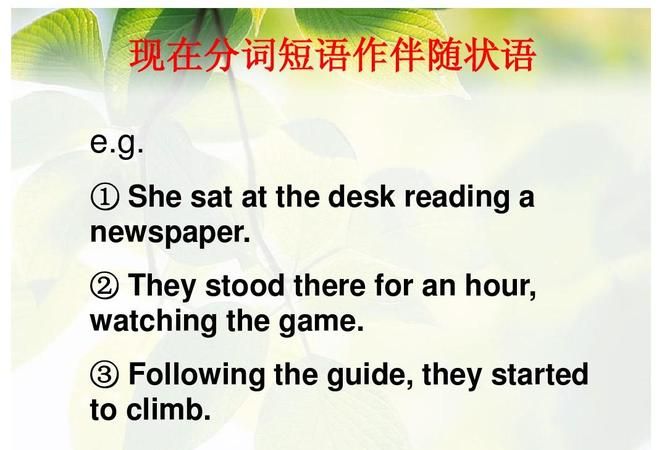本文目录
doing作状语时前面是否能省
doing做状语(就我所知),还可以表原因。如Fearing of being cheated, I kept silence in the train.
having done 和doing属于同一范畴,都是属于动词ing型,是非谓语动词。但是一般不会用来表结果,因为v-ing放句末就可以表结果了,为什么还要用having done 多此一举呢。
having done一般位于句首,做伴随或原因状语。因为有完成态在里面,所以这里面的动词的动作要与主句动词动作有一定时间的间隔。
如Having finished my homework, i went out to visit Tom.

doing的用法
doing
noun
(一般作 doings)the activities in which a particular person engages
活动
the latest doings of television stars.
电视明星们的最新活动。
■(informal)excrement, especially that of a domestic animal
(非正式)(尤指家养动物的)排泄物
■[in sing.](informal)a beating or scolding
(非正式)打;骂
someone had given her a doing.
有人揍了她一顿。
[mass noun]used to indicate that something is considered difficult to achieve
难做的事
it would take some doing to calm him down.
让他平静下来得花点心思。
(doings)[treated as sing. or pl.](informal, chiefly Brit.)used to refer to things when one has forgotten their name or when no one word easily covers them
(非正式,主 英)那些玩意(用来指忘了名称或说不清楚的东西)
the drawer where he kept the doings.
他放那些玩意的抽屉。
常用词组
be someone's doing
be the creation or fault of the person named
某人的作品(或过错)
he looked at Lisa as though it was all her doing.
他看着莉萨,好像都是她的错。
can’t be doing with
不能接受;无法忍受
I can’t be doing with people who complain all the time.
我无法忍受那些整天发牢骚的人。
take some doing; take a lot of doing
难以完成; 很困难
Getting it finished by tomorrow will take some doing.
要在明天完成有点难度。
It’s going to take some doing to do the report on time, but we should manage it.
要按时完成报告有难度,不过我们会设法完成的。
what is sb/sth doing … ?
某人/某物怎么在…
What are these shoes doing on my desk?
这些鞋怎么在我的桌子上?

doing作伴随状语的例句
现在分词短语作伴随状语
伴随状语出现的条件是:
1) 由一个主语发出两个动作
2) 或同一个主语处于两种状态,
3) 或同一个主语发出一个动作时又伴随有某一种状态。
伴随状语的逻辑主语一般情况下必须是全句的主语,伴随状语与谓语动词所表示的动作或状态是同时发生的。
'Can't you read?' Mary said angrily pointing to the notice.
She came running towards me.
The children ran out of the room, laughing and talking merrily.
They stood there for an hour, watching the game.
She sat at the desk reading a newspaper.
Traveling by jeep, we visited a number of cities.
Following the guide, they started to climb.
伴随状语首先是一种状语,用来修饰动词的,同时是表示与谓语动词同时进行,即伴随着谓语动词的动作同时进行。如:
He said it angrily pointing at the notice on the wall.
他生气地说着,手指着墙上的布告。
这里,point与said同时进行,因此,pointing在这里是现在分词作伴随状语,表示主动和正在进行。
例子:
1 He died doing what made him happiest.
2 He laughed looking at the funny boy.

doing的用法总结思维导图
1、不定式(todo):做主语、宾语、表语、定语、状语和补语。
2、动名词(doing):做主语、宾语、表语、定语。
3、现在分词(doing):做表语、定语、状语和补语。
读法 英 [ˈduːɪŋ] 美 [ˈduːɪŋ]
v. 做;干(do 的 ing 形式)
n. 活动;所作所为

短语
learning by doing 做中学 ; 从做中学 ; 干中学 ; 在做中学
be worth doing 值得做什么 ; 值得做 ; 值得 ; 值得做某事
Doing Business 做生意 ; 经商环境报告 ; 营商环境报告 ; 全球营商环境报告
oing well 经营盈利
doing business 做生意;经营商业
示例:
The shortest answer is doing.
最简短的回答是干。
以上就是关于doing作伴随状语的用法 ,doing作状语时前面是否能省的全部内容,以及doing作伴随状语的用法 的相关内容,希望能够帮到您。
